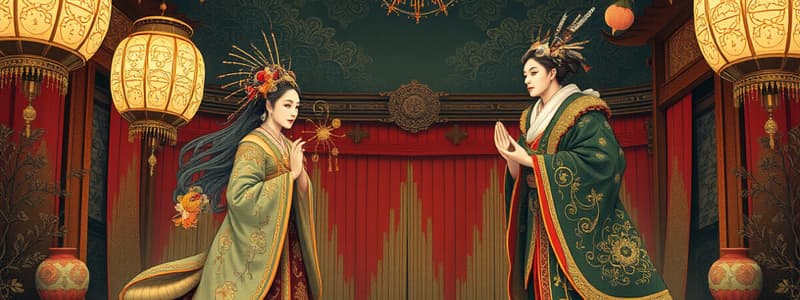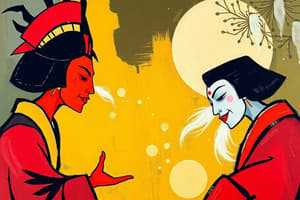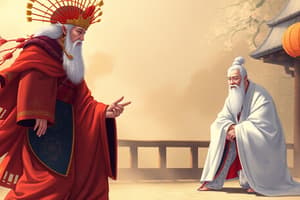Podcast
Questions and Answers
What are the three types of classical theatre of Japan?
What are the three types of classical theatre of Japan?
Noh, Kabuki, Bunraku
What is Noh's comic counterpart?
What is Noh's comic counterpart?
Kyogen
Which Japanese classical theatre is the oldest continually performed theatrical tradition in the world?
Which Japanese classical theatre is the oldest continually performed theatrical tradition in the world?
Noh
When was Noh perfected?
When was Noh perfected?
What is Noh theatre?
What is Noh theatre?
What are Noh Dramas?
What are Noh Dramas?
In Noh dramas, what is the single character that the play is centered around?
In Noh dramas, what is the single character that the play is centered around?
In Noh dramas, what is the name of the character who challenges the Shite?
In Noh dramas, what is the name of the character who challenges the Shite?
Which character is the only character to wear a mask during a Noh play?
Which character is the only character to wear a mask during a Noh play?
Why does Noh have a distinctive slow walk?
Why does Noh have a distinctive slow walk?
What is the bridge-like runway used in Noh plays?
What is the bridge-like runway used in Noh plays?
What three words does Kabuki originate from?
What three words does Kabuki originate from?
What are the three categories of Kabuki plays?
What are the three categories of Kabuki plays?
Kabuki has always been considered dinner theatre.
Kabuki has always been considered dinner theatre.
What is the name of the feature runway used in Kabuki?
What is the name of the feature runway used in Kabuki?
What is the name of the spot that is seven tenths away from the audience popular for speeches, etc.?
What is the name of the spot that is seven tenths away from the audience popular for speeches, etc.?
What is hikinuki?
What is hikinuki?
What is Onnogata?
What is Onnogata?
What are the two ways men's parts are played?
What are the two ways men's parts are played?
What is Bunraku?
What is Bunraku?
Flashcards are hidden until you start studying
Study Notes
Japanese Classical Theatre Overview
- Three prominent types: Noh, Kabuki, and Bunraku.
Noh Theatre
- Oldest continuously performed theatrical tradition in the world.
- Perfected in the 14th and 15th centuries by Kan'ami and Zeami, a father-son duo.
- A highly ceremonial form featuring supernatural characters, performed by actors trained from birth.
- Noh dramas reflect Shinto and Buddhist values, with plots emphasizing mood rather than action.
- The central character of Noh plays is called Shite, while the challenger is the Waki.
Noh Performance Characteristics
- Only the Shite character wears a mask.
- Unique slow walking style mimics traversing rice paddies.
- The bridge-like runway used in Noh is called the hashigakari.
Kabuki Theatre
- The term Kabuki derives from three words: Ka (song), Bu (dance), and Ki (skill).
- Kabuki plays are categorized into history plays, domestic dramas, and dance dramas.
- Historically referred to as dinner theatre.
Kabuki Performance Features
- The feature runway is known as the hanamichi.
- A notable performance spot, shichi-san, is positioned seven-tenths away from the audience for impactful speeches.
- Hikinuki technique allows for rapid costume changes during performances.
Special Character Roles in Kabuki
- Onnogata refers to male actors portraying female roles.
- Male roles can be performed in two styles: Aragoto (wild) and Wagoto (soft).
Bunraku Theatre
- Founded in the 17th century, it features puppetry that mimics the action of the play.
Studying That Suits You
Use AI to generate personalized quizzes and flashcards to suit your learning preferences.




